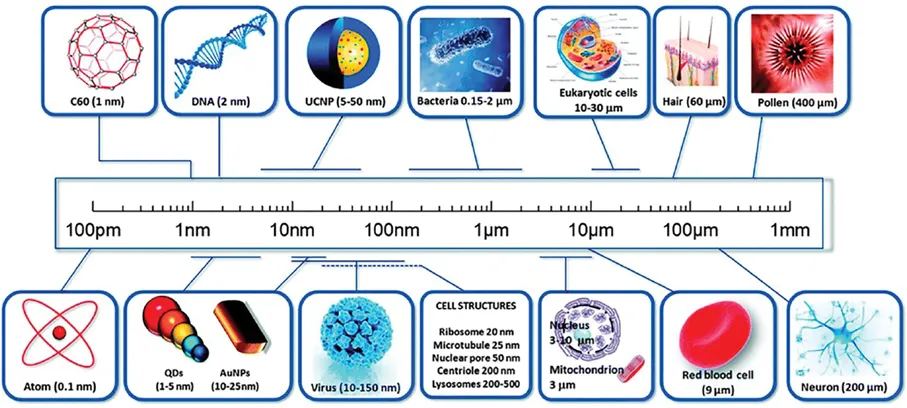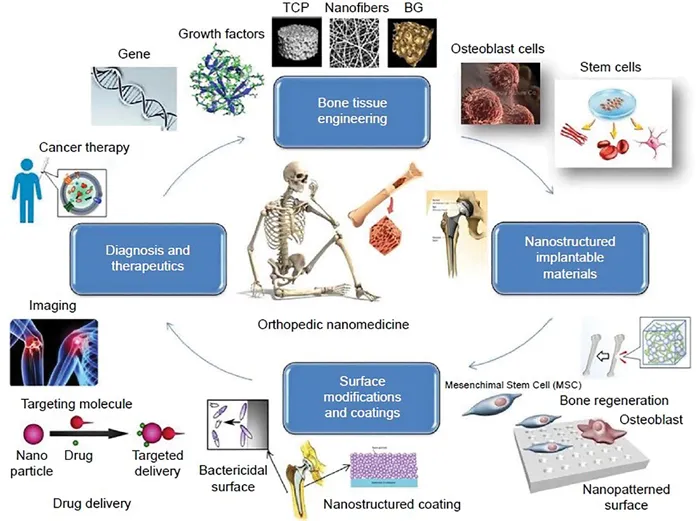
eBook - ePub
Nanomaterials and Nanocomposites
Characterization, Processing, and Applications
B. Sridhar Babu, Kaushik Kumar, B. Sridhar Babu, Kaushik Kumar
This is a test
Share book
- 168 pages
- English
- ePUB (mobile friendly)
- Available on iOS & Android
eBook - ePub
Nanomaterials and Nanocomposites
Characterization, Processing, and Applications
B. Sridhar Babu, Kaushik Kumar, B. Sridhar Babu, Kaushik Kumar
Book details
Book preview
Table of contents
Citations
About This Book
Nanomaterials and Nanocomposites: Characterization, Processing, and Applications discusses the most recent research in nanomaterials and nanocomposites for a range of applications as well as modern characterization tools and techniques. It deals with nanocomposites that are dispersed with nanosized particulates and carbon nanotubes in their matrices (polymer, metal, and ceramic). In addition, the work:
-
- Describes different nanomaterials, such as metal and metal oxides, clay and POSS, carbon nanotubes, cellulose, and biobased polymers in a structured manner
-
- Examines the processing of carbon nanotube-based nanocomposites, layered double hydroxides, and cellulose nanoparticles as functional fillers and reinforcement materials
-
- Covers size effect on thermal, mechanical, optical, magnetic, and electrical properties
-
- Details machining and joining aspects of nanocomposites
-
- Discusses the development of smart nanotextiles (intelligent textiles), self-cleaning glass, sensors, actuators, ferrofluids, and wear-resistant nanocoatings.
This book enables an efficient comparison of properties and capabilities of these advanced materials, making it relevant for materials scientists and chemical engineers conducting academic research and industrial R&D into nanomaterial processing and applications.
Frequently asked questions
How do I cancel my subscription?
Can/how do I download books?
At the moment all of our mobile-responsive ePub books are available to download via the app. Most of our PDFs are also available to download and we're working on making the final remaining ones downloadable now. Learn more here.
What is the difference between the pricing plans?
Both plans give you full access to the library and all of Perlego’s features. The only differences are the price and subscription period: With the annual plan you’ll save around 30% compared to 12 months on the monthly plan.
What is Perlego?
We are an online textbook subscription service, where you can get access to an entire online library for less than the price of a single book per month. With over 1 million books across 1000+ topics, we’ve got you covered! Learn more here.
Do you support text-to-speech?
Look out for the read-aloud symbol on your next book to see if you can listen to it. The read-aloud tool reads text aloud for you, highlighting the text as it is being read. You can pause it, speed it up and slow it down. Learn more here.
Is Nanomaterials and Nanocomposites an online PDF/ePUB?
Yes, you can access Nanomaterials and Nanocomposites by B. Sridhar Babu, Kaushik Kumar, B. Sridhar Babu, Kaushik Kumar in PDF and/or ePUB format, as well as other popular books in Technologie et ingénierie & Science des matériaux. We have over one million books available in our catalogue for you to explore.
Information
Section I
State of Art
1 Recent Developments in Nanomaterial Applications
S. Saravanan and E. Kayalvizhi Nangai
K. Ramakrishnan College of Technology
S. V. Ajantha
Madha Medical College Hospital and Research Institute
S. Sankar
Dongguk University Seoul V. Dhinakaran
Chennai Institute of Technology
Chennai Institute of Technology
Contents
1.1 Introduction
1.2 Nanomedicine
1.3 Application of Nanomaterials in Medicine
1.3.1 Nanomaterials in Tissue Repair and Regeneration
1.3.2 Nanomaterials in Implantation
1.3.3 Nanomaterials in Medical Devices
1.3.4 Nanomaterials in Diagnostic Tools
1.3.5 Nanomaterials in Pharmaceutics
1.4 Conclusion
References
1.1 Introduction
At the end of the 20th century, a wonderful new technology, called nanotechnology, has emerged. It is a technology that deals with very small-sized objects and systems by scheming the structures at the nanoscale and also with drawing, categorization, construction, and application of structures and devices at the nanoscale [1, 2, 3]. The term “nano” means dwarf, and a nanometer is one-billionth of a meter. In 1965, American physicist Nobel Richard Feynman distinguished some useful concepts in nanotechnology and stated that “the principles of physics, as far as I can see, do not speak against the possibility of maneuvering things atom by atom” [4]. Feynman’s definition was expanded by Drexler’s quote: “nanotechnology is the principle of atom manipulation atom by atom, through control of the structure of matter at the molecular level. It entails the ability to build molecular systems with atom by atom precision, yielding a variety of nanomachines [5]. Binning and Rohrer expounded on Drexler’s hypotheses in a handy manner. In 1981, they were the first to observe the particles to investigate nanotechnology. Researchers had the opportunity to get a handle on and prepare the particles for building structures. A remarkable feature of nanotechnology is the incomprehensibly expanded proportion of surface area to volume present in numerous nanoscale materials, which opens up additional opportunities in surface-based science, for example, catalysis. Nanotechnology has incredible accomplishments and tackles extraordinary issues; however, it will be like shrewd open doors for huge maltreatment. In nanomaterials, a maximum number of atoms are situated on the surface of the elements, so it has almost all the increasing surface area. They are generally classified into four categories based on the dimensional aspect such as zero-, one-, two-, and three-dimensional particles. The various dimensions of nanoparticles are shown in Figure 1.1 [6]. Nanomaterials lead to current development in the area of strong technical research, owing to an extensive range of prospective applications such as electronic, optical, and biomedical applications.

FIGURE 1.1 Size indications of nanomaterials.
Most biological molecules and structures are of a similar size to that of nanomaterials. Consequently, nanomaterials can be used for research and applications in both in vivo and in vitro biomedical fields. Hence, the combination of nanomaterials and biology plays a key role in the enhancement of diagnostic devices along with tools and drug delivery system [7, 8, 9, 10]. Biological tests are becoming faster, more aware, and flexible to measure the occurrence or action of chosen substances, while at the nanoscale, particles are set to work as tags or labels. To label these detailed molecules, structures using magnetic nanoparticles are bound to a suitable antibody. Genetic sequence in a model is detected by gold nanoparticles tagged by short segments of DNA [11]. Nanopore technology is used to analyze nucleic acids altering strings of nucleotides openly into electronic signatures. Costs and human suffering can be reduced by this highly selective approach. Dendrimers and nanoporous materials can hold tiny drug molecules transporting them to the preferred place. One more insight is based on small electromechanical systems. Nano electromechanical systems (NEMS) are being examined for the dynamic release of drugs. Iron nanoparticles or gold shells are used for important applications including cancer treatment [12, 13, 14, 15]. Recent pharmacological molecular entities are discovered by the selection of pharmaceuticals for specific people to maximize the effectiveness and minimize side effects, and drugs are delivered at targeted locations or tissues inside the body. Nanoparticles can render targeted and constant delivery of biological components to particular tissues with the least systematic side effects [16, 17].
1.2 Nanomedicine
The aspect of approaching health care in which explicit medicines for every patient are created in consideration of ecological, phenotypic, and genetic factors is known as personalized medicine. These factors have significantly affected the adequacy and security of the treatment. Nanomaterials have been utilized in the field of medicine for more than 130 years; particularly, colloidal silver was utilized for the anticipation of eye diseases, which in present used in medicine as one of the first nanomedicines and iron dextran. Nanomedicine is the use of nanoscale materials such as engineered nanodevices and nanostructures for preventing, screening, renovating, creating, and running human biological systems [18]. It focuses on the key enabling technologies such as molecular nanotechnology and molecular manufacturing. Human body requires effective catch-up of medicine. The result is the ability to examine and modify the human body entirely like fixing a machine these days [19]. New industrial revolution will be created based on the nano-concepts, but scientists and engineers from various fields work jointly to accomplish the vision. Nanorobots play a significant role in the prevention, diagnosis, and treatment of illnesses [20]. Drug delivery has become a research hot spot in the field of nanomedicine. RNA interference therapy is yet experimental and problematic because of its newness and also the lack of bioavailability. The tiny-sized cells take up lipid or polymer-based nanoparticles instead of being cleared from the body. Drug delivery systems should minimize side effects and possibly reduce both dose and dose frequency and improve the efficiency [21,22]. The pharmaceutical industry functioning further personally is expected to recognize the possibility of nanomedicine for incurable diseases.
1.3 Application of Nanomaterials in Medicine
This section briefly explains the broad range of nanomaterials that have been used for applications in nanomedicine such as tissue engineering, implantable devices, diagnostic tools, and drug delivery system.
1.3.1 Nanomaterials in Tissue Repair and Regeneration
Nanomaterials are designed to be compatible with the human body to replace and repair tissues. Bone and teeth are “hard” tissues which are pacified by reproducing tissues that are indifferent from the original. On a poor tissue implant interface, to overcome this, coating is necessary for different metallic implant materials. Implant design can increase the adherence properties of the natural and implant tissues [23]. “Soft” repair damaged tissues can be self-repaired by the body which results in scar formation on the body, skin, and other tissue can be replaced by graft material [24]. To restore regenerate tissue, a scaffold is necessarily bioresorbable that will act as a temporary structure. The scaffold material is essential for repairing and regenerating damaged tissues [25]. Advances in nanostructure production and improvement have a significant impact on tissue regeneration scaffolds. Polymers are explored based on the optical behavior of nanoparticles with the influence of hybrid scaffolds. Molecular imprints are prepared by using the nanotechnology for maximizing durable feasibility. Nanomaterial fabrication techniques are being investigated essentially for growing large complex organs. For example, heart valves are fabricated from nanopolymer materials such as polyvinyl alcohol (PVA) and seeded with fibroblasts and endothelial cells. Transparent composite hydrogels are made from PVA and subjected to in vitro biocompatibility evaluation with human corneal epithelia cells [26].
Nanomaterials play a vital role in the enhancement of function and compatibility of implantable medical devices. It will contain nanoscale materials with non-intrusive or minimally intrusive systems and smaller nanoscale systems. Functional electrical stimulation is a boon to the physically deformed people who lost their legs. This method is executed for the physically deformed people to energize the powerless limbs. The muscle fiber membrane is incorporated with potential-generating nanostructures which are increased with membrane permeability and improves the extracellular electrical stimulation. The various potential applications of nanomaterials for bone tissue engineering and bone implantations are shown in Figure 1.2 [27].

FIGURE 1.2 Nanomaterials for bone tissue and implantation applications.
1.3.2 Nanomaterials in Implantation
Nano-enabled technologies to provide a mixture of new huge surface area and ability to design more biocompatible nanomaterials and the purpose of coatings on implants are to raise the adhesion, stability, and lifetime. Ceramics such as calcium phosphate are extensively used for implant coatings and are made up of particles of nano-size. The nanomaterial properties can be maintained with the help of new low-temperature processes in electromagnetic fields. Implant nanomaterial coatings are being evaluated for improving the interface, and they can greatl...